You and I both know that our guided reading minutes are precious. Being able to read and discuss instructional-level texts in a small group setting is incredibly valuable for both teachers and students.
But what if you are being constantly interrupted during guided reading? What if you have to leave each group multiple times to re-direct students who are misbehaving or off-task? What if your guided reading instruction is suffering because the other students just can’t seem to work independently?
This is a challenge I’ve faced myself (repeatedly…multiple years and multiple times per year!), and one that I know other teachers deal with, too.
And there’s no “one-size-fits-all” solution. But in this post, I’ll offer up several different strategies that you can try. If you change up just one thing at a time, see how it works, and adjust accordingly, hopefully you will find a solution that meets the needs of your class.
Until you do find a solution that works, grant yourself a little grace. You may need to scale back your guided reading small group instruction, or even cancel it for a couple of days so that you can support students as they re-learn routines and expectations.
Your students will not fail as readers if they miss a little guided reading! Quite the opposite – they will become stronger readers due to the more focused guided reading instruction you’ll soon be able to give them. And they’ll also become more independent workers who are able to focus on tasks even without your direct supervision.
It is a-okay to take a step back in order to take a couple of steps forward. It doesn’t mean that you’ve done anything wrong as a teacher. Teaching is all about recognizing problems and figuring out how to solve them – it’s just the nature of the job.
So let’s dive in – here are 5 strategies to try when your students are struggling to work independently!
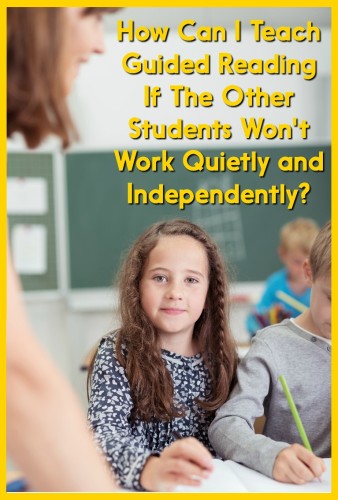
Photo credit: Racorn from Shutterstock
Evaluate Your Independent Work Tasks
When students are struggling to work independently, the first thing I ask myself is, “How appropriate are the tasks I’m asking them to do independently?” I ask myself…
- Are the tasks too easy?
- Are the tasks too difficult?
- Are the tasks engaging?
- Do students know what they are supposed to do?
- Are students finishing early?
- Are students working in groups where they get along well and can work productively together?
The best way to answer these questions is to observe students as they work on whatever tasks you have assigned to them. I recommend taking a day off from guided reading. You can mention to students that you won’t be seeing groups, but don’t explain why. You can tell them that you are going to be “busy” writing some things down and that they should work independently as always.
Assign students the same centers or literacy tasks they would ordinarily do while you teach guided reading. Then, as students work, casually and quietly wander around the room. Observe them as they work, but do not interact with them. Take notes about what you see.
Look for positive behaviors like:
- Getting started right away
- Staying in their seat
- Asking a friend for help, if necessary
- Using a quiet voice
- Following directions on a task
- Quickly and easily locating materials
- Spending an appropriate amount of time on a task
- Seeking out another activity after finishing one task
- Successfully solving problems or conflicts with other students
And look for less-desirable behaviors like:
- Getting up frequently
- Using the bathroom or getting a drink frequently
- Looking around the room
- Starting conversations with other students
- Arguing with other students
- Using a loud voice
- Looking confused or completing a task incorrectly
- Spending way too long on a task
- Completing a task far too quickly
- Sitting and doing nothing after finishing a task
These behaviors may vary depending upon the tasks on which students are working. If you’d like a general checklist to fill out as you “walk the room,” click on the photo below to download it for free.
Based upon your notes, you may be able to make some decisions about what you’ll need to adjust. Perhaps some of the students find the tasks too easy (they complete them quickly, start chatting with other students, etc). You can use different centers or different colored folders to provide more challenging tasks.
Alternately, you may find that some tasks are too difficult for certain students. You may see that these students take a long time to get started, spend too long on each task, ask for help from other students, avoid work by getting up frequently, and/or fail to complete the tasks. You may need to adjust independent work for these students.
If multiple students seem disengaged (avoiding work, getting up frequently, talking with other students often), perhaps it’s time to change up the tasks you’re giving them. If students spend much of the time reading, rotate the books in your classroom library or have students give “book talks” to each other to recommend new books.
If basic behavior is the key issue (arguing, getting up frequently, sitting and doing nothing), then you’ll probably need to re-teach expectations.
Re-Teach Expectations
Just as we teach students academic skills, we have to teach (and re-teach) our expectations for behavior. If you spent a lot of time teaching independent work expectations at the beginning of the year, it can be frustrating to have to start all over. But it’s time well-spent – getting them back on the right track will help you improve your guided reading instruction and students’ learning as they work independently!
Before you begin re-teaching expectations, make sure you clearly define your own expectations. Consider things like:
- Can students interrupt you while you’re teaching guided reading? If so, for what reason (i.e. emergency)?
- May students use the restroom? Get a drink of water?
- What should students do if they forget what they’re supposed to be working on? Can they ask another student?
- Should students be working silently or using a whisper voice?
- When are students allowed to get up out of their seats?
- When are students allowed to talk to others?
- What should students do when they complete one task?
- What should students do if they need help with a task?
- What should students do if someone else is bothering them?
I’m sure I’m forgetting something, but you get the gist. Kids need to learn how to problem-solve independently and deal with the myriad of issues that may arise as they work independently.
I like sitting down with the class and making a “What If?” anchor chart to help them during independent work time. I don’t have a photo of the charts I’ve made in the past, but they are simple t-charts with “What If?” written on the left side and “Then…” written on the right side. Here were the expectations I had for my 2nd graders during independent work time.
What if someone is hurt or very sick? Then, please interrupt me!
What if I need to use the restroom? Then, check to see if the pass is available, and if it is, sign out and go. Come back quickly.
What if I need to get a drink of water? Then, drink from your water bottle or wait until guided reading is over to use the water fountain.
What if I forget what to do? Then, quietly ask a friend. Ask another friend if you still don’t know.
What if someone is bothering me? Then, please ask them to stop. Ignore them or move to another spot if you can.
What if I need help with my work? Then, quietly ask a friend. Do the parts that you can do, and I will help you after guided reading time is over.
Again, I’m sure I’m forgetting some, but hopefully these examples can get you started. We also had certain guidelines like “Use a quiet voice” and “Stay in your spot.”
To help students adhere to these expectations, you might try two things. First, get some sort of light, hat, or other signal to show students when you may not be interrupted (as you teach guided reading). Second, if students work in groups, try assigning a “group leader” who is responsible for helping students who need assistance.
You may need to teach a couple of minilessons to get students back on the right track. After you teach a minilesson, give students an opportunity to work independently as you observe. Don’t pull a guided reading group – instead, just watch and make note of students who are following expectations. Following a brief independent work period, have students come back together. Have them tell you what they think went well and didn’t go well. You can also point out several students who you noticed following directions.
Re-Teach Independent Tasks
In addition to re-teaching behavioral expectations, you may also need to re-teach the independent tasks students must complete (even if they’ve been doing them all year!).
Before you re-teach the tasks, make sure you’re satisfied that the activities meet students’ needs. Think about how you could differentiate by having different colored folders for different guided reading groups. For example, you could have students play a sight word game, but each group has their own bag of words to work with. Or, you could just have students visit different centers depending upon their levels.
I don’t recommend having students always work in same-ability groups, however. Make sure to find opportunities for students of different levels to work together. Partner reading, acting out a big book you’ve already read, listening to stories on tape or on the computer, and writing about texts are all activities that can be done in mixed-ability groups.
I also try to make sure that tasks are as engaging and meaningful as possible. Although it’s definitely helpful to use centers for practicing sight words and phonics patterns, I try to incorporate a lot of “real” reading and writing.
Once I know what tasks I want students to complete, I like to take a “one at a time” approach to teaching them. I teach just one task or activity at a time, model it, everyone in the class practices it at the same time, and then we start over with a different task (I just do one per day, however).
Once students have learned a couple of independent tasks, I then “release” these tasks into centers or assign them as independent work. (To read more about how I teach students to work in centers, click HERE).
However, if you find that having students work with their peers just ISN’T working right now, consider modifying the type of work you assign.
Because as much as I love partner games and group activities, sometimes a student (or students) just need to master working by themselves first. And that’s okay!
If you need engaging “solo” activities so that students can strengthen their independent work skills, check out my Solo Literacy Centers.
Many of the solo literacy center activities are designed to feel “game-like” – they’re not your average worksheet! They provide meaningful independent practice for those times when you need students to work on their own.
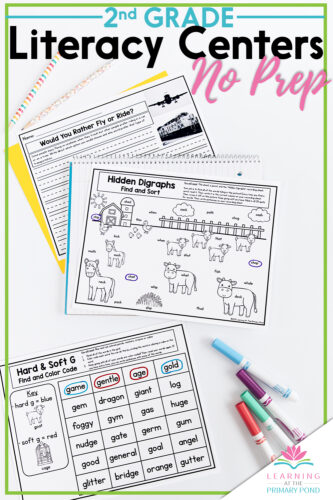
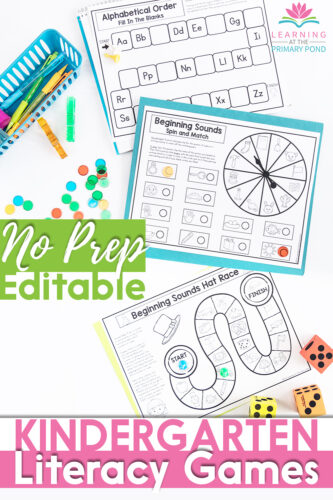
Support Students in Building Stamina
Have you ever been asked to sprint a mile when you’ve only ever jogged for five minutes at a time? I hope not, because it probably wouldn’t go too well. 😉
Similarly, we need to remember that students need time to build up their independent work stamina. Many teachers spend time building up reading or writing stamina at the beginning of the school year. You can use the same concept to help students build stamina during independent work time.
First, have students work independently. Time them with a stopwatch. The very second that someone gets off-task or noisy, stop them. Bring everyone back to the rug and share the number of minutes (or seconds…) that they were able to work independently. You can start a bar graph with the number of minutes, if you like.
Release them back to their seats to try again. Again, time them and bring them back when someone gets off-task. You may need to do this a couple of times each day, for several days in a row.
The kids will probably get tired of coming back to the rug again and again. Instead of blaming, say something like, “I know, I think it’s a little bit frustrating, too! When we all work together, I know we can build up our independent work stamina so we can work for an entire 30 minutes. We will keep trying until we get there.” This sends the message that you are all a team, working together towards the same goal.
Consider Alternative Seating and Supervision Options
Sometimes you might try all of the things I’ve described above and it still doesn’t work – kids are still having trouble working independently. Trust me, I’ve been there…I’ve had “that class” more than once!!
If you have a tough group of kids who have trouble working together, having kids work in groups may not be an “all the time” thing. You may have just one center where students work together, and all of the other centers consist of quiet, independent work.
Having students work in pairs is another alternative to small group work. Two children working together tend to be quieter than a small group!
Regardless of whether students are working independently or together, spread them out throughout the classroom. They will love the chance to sit in “fun places” like under a table, on the group rug, etc. Invest in some inexpensive clipboards to give students hard surfaces to work on. Spreading kiddos out strategically can help significantly with the noise level in your classroom.
Seeking out adult supervision is another great way to help students who struggle to work independently. If you have time with an aide, schedule their minutes during centers. If you don’t, ask for parent volunteers. You can pretty easily train them to help students resolve problems, and parents will love to be involved in the classroom!
Sometimes you may have a student who just is not ready to work independently yet. And you know what? That’s okay. Kids have different needs and develop differently.
If you find yourself in this situation, have the child sit next to your small group table for the entire independent work period. Don’t treat it as a punishment, but do explain to the child that he may choose to go back to his regular spot when he is successful working quietly and independently.
Your Turn
I bet you have some tips or tricks for getting students to work independently, and I’d love it if you shared! Please comment below – we can all benefit from sharing ideas about this!
If you’re looking for ideas about what to teach students when they’re meeting with you for guided reading, check out these resources.
Happy teaching!




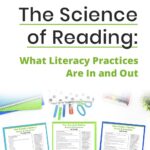
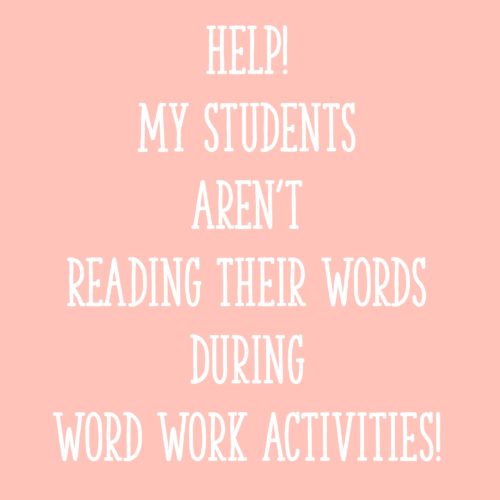
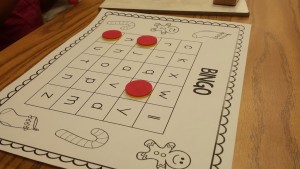







Great advices! always nice and refreshing to read what you share!
Thank you, Alison for the checklist!
You are so welcome! 🙂
Alison
Thank you for the advise
i am so glad that i found your site. you’ve presented so many wonderful ideas that refresh those of us who’ve been at this a long time.. i’ll keep this checklist to use when the next school year begins. 🙂
So glad it’s helpful, Jewel! Thanks for reading and commenting! 🙂
Alison
Your posts are such good refreshers for us veteran teachers, as well as an awesome source for all new teachers. The freebies you include are always so helpful. I know this will help me identify and correct any problem behaviors quickly at the start of next year. Thank you ~ Caroline
Thanks so much for the kind words, Caroline!! And I’m glad this will be helpful for you – always nice to have a refresher! 🙂
Alison
I have “that class” this year, no matter how many times I teach the procedures, none of them can handle working independently! I’m hoping some of your tricks will help us!!
I hope so too, Meghan!! Good luck! 🙂
Alison
Thanks this looks like what I need. SUE
Super helpful! I am going to start with the checklist tomorrow….thank you!
Good!! You’re welcome! Let me know how it goes! 🙂
Alison
Makes me feel like I’m not alone. Thank you.
This is what I was looking for, thanks!
I have been searching for a post just like this for so long. I am so grateful to have found you! This is exactly what I needed to read. I have some pretty challenging behaviors in my class. You’ve given me some great ideas, and also reassured me that this will take time. I’ll keep you posted. Thank you!
Kathy, I’m so glad this was helpful to you!! Do keep me posted – I hope the ideas help!
Alison